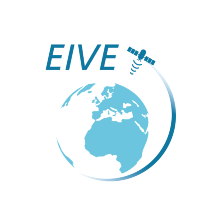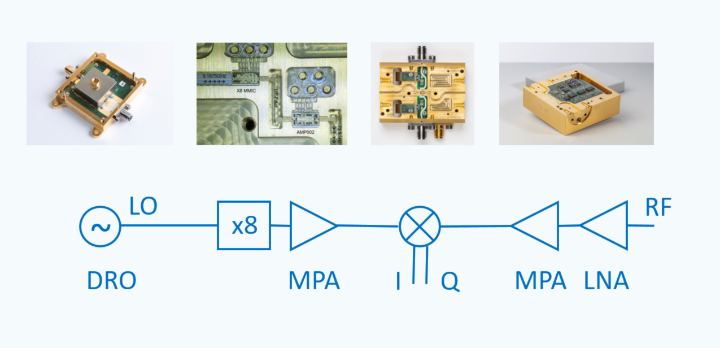Motivation
In order to allow new frequency ranges for broadband satellite communication and to ensure the steadily growing demand for higher data rates, we propose the world's first in-orbit verification of a communication link in the E-band [1] with the project EIVE.
A data downlink in the frequency range 71-76 GHz from a nanosatellite to a ground station is planned. Detailed link budget calculations show the feasibility of a transmission in a polar low-earth orbit with a very large bandwidth of 5 GHz while using realistic compact antenna dimensions.
State-of-the art compound semiconductor technologies were used to design e.g. GaN solid-state power amplifiers (SSPA) and GaAs low-noise preamplifiers (LNA) developed by project partners in previous DLR projects. Using this existing hardware, record terrestrial other-the-air data transmission in the E-band of up to 6 Gbps over 37 km distance was already achieved and a 9.6 Gbps transmission was demonstrated using an aircraft at a distance of up to 12 km from a ground station with antenna tracking.
The partners of the EIVE project group are highly qualified for the implementation of this project due to their extensive know-how in their respective field which perfectly fits to the required competencies necessary to successfully carry out the EIVE project. In the DLR projects GISALI, ACCESS and ELIPSE coordinated by the group led by Prof. Kallfass, the Fraunhofer IAF, the Karlsruhe Institute of Technology, the Radiometer Physics GmbH and the University of Stuttgart developed the existing E-band technology platform and demonstrated the worldwide first data transmission between an aircraft and a ground station. The group led by Prof. Klinkner at the University of Stuttgart developed and operates the small satellite "Flying Laptop". The Tesat Spacecom is another industry partner with extensive expertise in space technologies and applications.
On the one hand, with the planned data downlink from a Cubesat platform to the ground station, the feasibility of high speed data links in a new frequency range for satellite communications will be assessed in an in-orbit scenario. On the other hand, applications and services for earth observation will be addressed with the planned payload, since in the future, such applications could increasingly be served by nanosatellites in the low-earth-orbit (LEO). For various applications based on W-band satellite communications such as e.g. Inter-satellite links (ISL) or duplex-capable data links for global mobile and Internet coverage via satellite networks (5G, 6G, etc.), innovative platforms such as small satellites with correspondingly more complex payloads and innovative antenna technologies will be highly attractive in the future.
[1] The ITU regulated frequency bands at 71-76 GHz (downlink) and 81-86 GHz (uplink) are in the so-called E-band (WR12, corresponding to the 60-90 GHz frequency range). The ESA has used the term W-band (WR10, corresponding to the 75-110 GHz frequency range) for these frequency ranges in recent ITTs.
Objectives
Mission Objectives
- Demonstration of an RF link in the E-band at 71 - 76 GHz between a satellite and a ground station.
- The RF link shall achieve a RF bandwidth of 5 GHz with a useful bandwidth of 2.5 GHz.
- The influence of different weather phenomena (e.g. clouds, rain, snow, ...) on the RF link shall be characterised.
- Pseudo-random data created by an arbitrary waveform generator shall be looped continuously at a sample rate of 2.5 GSps. Different modulation schemes may be used during the transmission of pseudo-random data.
Secondary Objectives
- Uncompressed video data from a high-resolution camera shall be transmitted via the E-band transmitter live and in real time. This should demonstrate that aside from known data, real data can be transmitted at a high bandwidth.
Tertiary Objectives
- Video data should be able to be stored on-board of the EIVE satellite in a compressed format.
- Arbitrary data stored on-board the CubeSat shall be transmitted via the E-band transmitter using different modulation schemes.
- The video camera should be used for Earth observation purposes.
Schedule
| 2019 | Start of project |
| 2020-2023 | Integration / test campaign |
| 2023 June | Launch |
| 2023-2024 | EIVE mission |
E-Band Transmitter
The E-band payload consists of two self-developed GaN Solid State Power amplifiers as well as a low-noise GaAs pre-amplifier. A block diagram of the E-band transmitter is shown above this text. A horn antenna with a high gain is used in order to achieve a positive link budget. The utilised radiofrequency components are mounted on the body of the horn antenna which serves as a capacitive heat sink for the dissipated energy during the ground station passes.
Video Camera
The need for a high-bandwidth data source drove the decision to implement a high-resolution video camera to utilise the entire bandwidth of the link. The camera can be further used for Earth observation purposes as well.
Data generation / Arbitrary Waveform Generation
A computationally powerful miniaturized FPGA-based digital processing unit, multiMIND, in combination with a 12 GSps D/A extension board is used to feed the high-speed analog link. The payload computer is used to function as a miniaturized arbitrary waveform generator, to store, compress, frame and modulate the images in order to be transmitted through the E-Band link.
The satellite bus serves as the carrier of the payload and enables its operation with respect to the requirements and constraints of the mission.
Structure
A 6U structure (100 mm x 220 mm x 340 mm) was chosen as the base of the EIVE CubeSat.
Electric Power Supply
Two deployable solar panels supported by two body-mounted solar panels with 14 solar cells each supply the power needed for the operation of the EIVE CubeSat. A lithium ion battery will maintain the system during the eclipse phases. A power control and conditioning unit regultates the solar power and supplies each subsystem with the appropriate voltages while also implementing the necessary safety features. Most subsystems can be independently switched on and off.
Attitude Control System
The EIVE CubeSat employs a variety of attitude sensors and actuators. Angular rates and the magnetic field strength are measured by a combination of different MEMS sensors. Additionally, segmented photo diodes enable the determination of the sun vector in relation to the body frame. In order to comply with the demand for a high-precision attitude accuracy during the payload operation, a star tracker will be used. Thus, the pointing knowledge can be pushed well below one degree. Magnetorquers enable a coarse attitude control, whereas reaction wheels will be used to increase the agility and the pointing accuracy during the payload operation.
On-board Computer
The on-board computer of the EIVE CubeSat is build around a Xilinx Zynq 7020 System-on-a-Chip comprising an ARM microprocessor as well as an FPGA. The flight software is based on the successful flight software framework of the Flying Laptop satellite.
Communication
The EIVE CubeSat will use an S-Band transceiver with a downlink frequency of 2263.5 MHz for telemetry and data as well as an uplink frequency of 2083.5 MHz for tele-commands. Two low-gain patch antennas mounted on opposing sided of the CubeSat structure will offer an almost omni-directional coverage. The RF link will use the well-established CCSDS protocol.
Thermal Control System
The thermal control system bundles temperature measurements of board mounted sensors as well as 16 resistance temperature devices. Six film heaters can be used to increase the temperature of critical subsystems if needed. The satellite will be cooled entirely passive.
Location
The main ground station of the EIVE mission will be located at the campus of the University of Stuttgart in Vaihingen. Additional ground stations of the IRS partners around the globe are available for the reception of telemetry and payload data as well as in exceptions the transmission of tele-commands both in the S-band frequency range. The reception of E-band signals will be solely conducted via the ILH ground station in Vaihingen.
E-Band Receiver
The E-band signals are received with a parabolic antenna with an integrated LNA, an AGC circuit, a broadband downconverter and a base-band amplifier. The digitalisation and processing of the received signals is done in the consecutive steps. A block diagram of the signal path is displayed above this text.
S-Band Transceiver
Tele-commands and telemetry are received and send using the already existing parabolic antenna with an integrated CORTEX receiver located at the IRS. The operation of the S-band ground station will be modified in the near future to comply with the demands for multi-mission / multi-ground station capabilities.
EIVE E-band Ground Station
Project Partners
Institute of Robust Power Semiconductor Systems
The Institute of Robust Power Semiconductor Systems of the University of Stuttgart manages the EIVE project.
Main tasks of the space segment are the design, integration and operation of the basis band payload. Concerning the ground segment, the ILH supervises the operation of the payload and the scientific analysis of the gathered data.
Institute of Space Systems
The Institute of Space Systems of the University of Stuttgart is responsible for the design, construction and integration of the satellite bus. Further, the IRS manages the satellite operation utilising the IRS ground station as well as external ground stations.
Fraunhofer-Institute for Applied Solid State Physics
The Fraunhofer-Institute for Applied Solid State Physics works on the E-band payload by developing the GaN-Solid-State-Power-Amplifier (SSPA) as well as the low-noise mHEMT receiver amplifiers (LNA).
RPG-Radiometer Physics GmbH
The Radiometer Physics company develops the E-band horn antenna for the CubeSat as well as the E-band antenna and electronic components for the ground station's reception antenna. This includes the RF tracking of the E-band signal.
Tesat-Spacecom GmbH
Tesat-Spacecom supports the EIVE project by offering advice and guidance in the fields of space electronics, radiation tolerance, project management as well as industrialisation.
Co-operation Partners
Thales Alenia Space Deutschland GmbH supports the project by provision of its multi-purpose payload processing system “multiMIND” as central element of the payload computer.
Project Grant
The EIVE project is financially supported by the Federal Ministry for Economy Affairs and Climate Action (BMWK) and the German Aerospace Center (DLR) under grant number 50RK1960.
The EIVE core team at the University of Stuttgart
Press Coverage
| 2019-10-24 | golem.de | Nanosatelliten bringen Gigabit bei 71 bis 86 GHz |
| 2019-10-23 | Informatikdienst Wissenschaft | Schnelles Internet: Jederzeit und über-ALL |
| 2019-10-23 | raumfahrer.net | EIVE: Erschließung neuer Frequenzbänder |
| 2019-10-23 | Clusterportal Baden-Württemberg | Deutsche Forscher arbeiten an der Erschließung neuer Frequenzbänder |
| 2019-10-23 | Hochschulkommunikation Uni Stuttgart | Schnelles Internet: Jederzeit und über-ALL |
| 2020-09 | Magazin forschung-leben | Minisatellit erprobt schnellere Datenübertragung aus dem All |
Publications
- B. Schoch, S. Chartier, U. Mohr, M. Koller, S. Klinkner and I. Kallfass, "Towards a CubeSat Mission for a Wideband Data Transmission in E-Band," 2020 IEEE Space Hardware and Radio Conference (SHaRC), San Antonio, TX, USA, 2020, pp. 16-19., DOI: 10.1109/SHaRC47220.2020.9034007
- I. Kallfass, L. Manoliu, B. Schoch, M. Koller, S. Klinkner, J. Freese, A. Tessmann, R. Henneberger, "Towards the Exploratory In-Orbit Verification of an E/W-Band Satellite Communication Link", 2021 IEEE MTT-S International Wireless Symposium (IWS), 2021, pp. 1-3, doi: 10.1109/IWS52775.2021.9499586.
- L. Manoliu, S. Kumari, I. Kallfass, "Variable-Coded Modulation and Error-Free Transmission Algorithms for an Exploratory In-Orbit Verification of an E-Band (71-76 GHz) Satellite Link", in Proc. 2021 38th Internation Communication Satellite Systems Conference (ICSSC), 2021.
- M. Koller, L. Loidold, L. Manoliu, J. Meier, I. Kallfass, and S. Klinkner, “The EIVE Cubesat - Developing a Satellite Bus for a 71-76 GHz E-Band Transmitter Payload," 35th Annual Small Satellite Conference, Logan, Utah, 2021.
- L. Manoliu, B. Schoch, M. Koller, J. Wieczorek, S. Klinkner and I. Kallfass, "High-speed FPGA-Based Payload Computer for an In-Orbit Verification of a 71–76 GHz Satellite Downlink," 2021 IEEE Space Hardware and Radio Conference (SHaRC), San Diego, CA, USA, 2021, pp. 21-24, DOI: 10.1109/SHaRC51853.2021.9375827.
- L. Manoliu et al., "Ultra-High Throughput E/W-Band Downlink CubeSat Mission", 73rd International Astronautical Congress (IAC), Paris, France, 18-22 September 2022.
- M. Koller et al., "Next on the Pad: The E-band Technology Demonstration CubeSat EIVE", 73rd International Astronautical Congress (IAC), Paris, France, 18-22 September 2022.
- B. Schoch et al., "E-Band Transmitter with 3 W Complex Modulated Signal Output Power Performance," 2021 51st European Microwave Conference (EuMC), 2022, pp. 458-461, doi: 10.23919/EuMC50147.2022.9784314.
- D. Wrana, B. Schoch, L. Manoliu, S. Haußmann, A. Tessmann and I. Kallfass, "Investigation of the Influence of LO Leakage in an E-Band Quadrature Transmitter," 2022 14th German Microwave Conference (GeMiC), 2022, pp. 33-36, link.
- B. Schoch et al., "Performance Optimization of an E-Band Communication Link using Open-Loop Predistortion," 2022 14th German Microwave Conference (GeMiC), 2022, pp. 216-219, link.
- S. Haussmann et al., "Measurement and Analysis of FDM for E-Band Satellite Communication," 2023 53rd European Microwave Conference (EuMC), Berlin, Germany, 2023, pp. 356-359, doi: 10.23919/EuMC58039.2023.10290622.
- L. Manoliu, D. Wrana, B. Schoch, S. Haussmann, A. Tessmann and I. Kallfass, "Frequency and Phase Investigation of the Local Oscillator Offset in a W-Band Satellite Communication Link," 2023 53rd European Microwave Conference (EuMC), Berlin, Germany, 2023, pp. 360-363, doi: 10.23919/EuMC58039.2023.10290372.
- M.T. Koller, L. Bötsch-Zavřel, M. Eggert, et al., "EIVE Lessons Learned and First Results of the E-band CubeSat EIVE," 2023 Deutscher Luft- und Raumfahrttechnikkongress (DLRK), Stuttgart, Germany, 2023.
- M. Eggert, L. Bötsch-Zavřel, M. Fugmann, et al., "Qualification of the Attitude Control System of the E-band CubeSat EIVE," 2023 Deutscher Luft- und Raumfahrttechnikkongress (DLRK), Stuttgart, Germany, 2023.
- H. Gibson, R. Henneberger, A. Tessmann, L. Manoliu, and B. Schoch, “A satellite tracking system at 78 GHz using the over-moded TE21 ground-station antenna pattern,” presented at the 1st Space Microwave Week, 2023.
- I. Kallfass, L. Manoliu, B. Schoch, S. Haussmann, A. Tessmann, R. Henneberger, J. Freese, “A W-Band Transmitter Scientific CubeSat Payload,” presented at the 1st Space Microwave Week, 2023.
- L. Manoliu, B. Schoch, S. Haussmann, A. Tessmann, R. Henneberger, J. Freese, et al., "The technology platform of the EIVE CubeSat mission for high throughput downlinks at W-band", Acta Astronautica, vol. 205, pp. 80-93, 2023, [online] Available: https://www.sciencedirect.com/science/article/pii/S0094576523001042.
- B. Schoch et al., "E-Band Active Upconverter Module with Tunable LO Feedthrough," 2023 IEEE Radio and Wireless Symposium (RWS), Las Vegas, NV, USA, 2023, pp. 80-83, doi: 10.1109/RWS55624.2023.10046296.
Participation at Conferences / Workshops
- Schoch et al., „Link-Budget Analysis of W- and E-Band Satellite Services“, 6. Nationale Konferenz „Satellitenkommunikation in Deutschland“ 2019, Poster Session, Bonn, Deutschland.
- Mohr et al., „Exploratory In-Orbit Verification of a Wideband E/W-Band Data Downlink“, 12th Pico- and Nano-Satellite Workshop (PiNA), 12-13. September 2019, Würzburg, Deutschland.
- German Center for Satellite-Communications r.S.. (DeSK), Zukunftsworkshop, 27. September 2019, Steinheim an der Murr, Germany.
- Schoch et al., „Link-Budget Analysis of W- and E-Band Satellite Services“, 25th Ka and Broadband Communications Conference, 30. September - 2. October 2019, Sorrento, Italy.
- Flexible Antennenkonzepte für die zukünftiger Satellitenkommunikation, Poster and Live Demo, Rhode & Schwarz, 21. November 2019, Munich, Germany .
- L. Manoliu et al., „FPGA Based Reconfigurable On-Board Payload Processing for an Exploratory In-Orbit Verification of an E-Band (71-76 GHz) Satellite Link (EIVE)”, submitted to the 5th SpacE FPGA Users Workshop (SEFUW), Noordwijk, The Netherlands.
- M.T. Koller et al., „The Exploratory In-orbit Verification of an E-band Link (EIVE) CubeSat Project”, submitted to the 10th Nano-Satellite Symposium, July 8-11, 2020, Istanbul, Turkey.
- German Center for Satellite-Communications r.S.. (DeSK), Network meeting, 7. October 2020, online.
Information for Students
The EIVE project continuously offers opportunities to conduct bachelor or master theses as well as to do student assistant positions. Open positions can be found on the ILH and IRS pages linked below. Student interested in these opportunities or further not published topics should contact the appropriate person at the ILH or IRS.
- Theses opportunities at the ILH
Contact: Benjamin Schoch, Laura Manoliu, Simon Haußmann, Ingmar Kallfass - Theses opportunities at the IRS
Contact: Markus Koller, Lukas Loidold, Jakob Meier, Sabine Klinkner

Benjamin Schoch
M.Sc.Research Assistant











